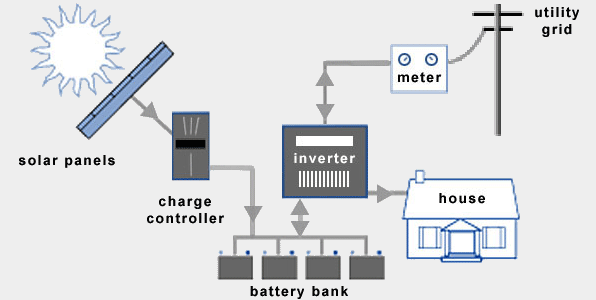Hybrid Solar Systems
A Hybrid solar systems combines the best from grid-tied and off-grid solar systems. These systems can either be described as off-grid solar with utility backup power, or grid-tied solar with extra battery storage.
If you own a grid-tied solar system and drive a vehicle that runs on electricity, you already kind of have a hybrid setup. The electrical vehicle is really just a battery with wheels.

Advantages of Hybrid Solar Systems
- Less expensive than off-gird solar systemsHybrid solar systems are less expensive than off-grid solar systems. You don`t really need a backup generator, and the capacity of your battery bank can be downsized. Off-peak electricity from the utility company is cheaper than diesel.
- Smart solar holds a lot of promise
The introduction of hybrid solar systems has opened up for many interesting innovations. New inverters let homeowners take advantage of changes in the utility electricity rates throughout the day.
Solar panels happen to output the most electrical power at noon – not long before the price of electricity peaks. Your home and electrical vehicle can be programmed to consume power during off-peak hours (or from your solar panels).
Consequently, you can temporarily store whatever excess electricity your solar panels in batteries, and put it on the utility grid when you are paid the most for every kWh.
Smart solar holds a lot of promise. The concept will become increasingly important as we transition towards the smart grid in the coming years.
Equipment for Hybrid Solar Systems
Typical hybrid solar systems are based on the following additional components:
- Solar Charge Controller
Solar charge controllers are also known as charge regulators or just battery regulators. The last term is probably the best to describe what this device actually does: Solar battery chargers limit the rate of current being delivered to the battery bank and protect the batteries from overcharging.
Good charge controllers are crucial for keeping the batteries healthy, which ensures the lifetime of a battery bank is maximized. If you have a battery-based inverter, chances are that the charge controller is integrated.
- Battery Bank Without a battery bank (or a generator) it’ll be lights out by sunset. A battery bank is essentially a group of batteries wired together.
- DC Disconnect SwitchAC and DC safety disconnects are required for all solar systems. For off-grid solar systems, one additional DC disconnect is installed between the battery bank and the off-grid inverter. It is used to switch off the current flowing between these components. This is important for maintenance, troubleshooting and protection against electrical fires.
- Battery-Based Grid-Tie Inverter
Hybrid solar systems utilize batter-based grid-tie inverters. These devices combine can draw electrical power to and from battery banks, as well as synchronize with the utility grid.
- Power Meter
It takes a lot of money and big batteries to prepare for several consecutive days without the sun shining (or access to the grid). This is where backup generators come in.